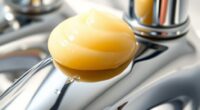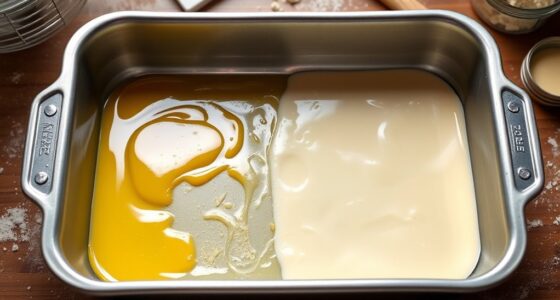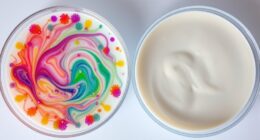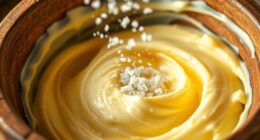Using butter and baking soda is a simple, natural way to minimize shallow scratches on your wood furniture. Applying butter fills in light scratches with fats, helping them blend in, while baking soda gently buffs out minor imperfections with its abrasive properties. For best results, clean the area first, apply the mixture along the grain, and gently press it into the scratch. Keep reading to discover tips that will help you achieve a seamless repair and protect your wood surfaces.
Key Takeaways
- Butter fills shallow scratches by smearing fats into the wood grain, reducing visibility.
- Baking soda acts as a gentle abrasive to buff out minor surface scratches.
- Apply both along the wood grain, pressing lightly with a soft cloth or finger.
- Use sparingly to avoid uneven texture or dullness; test on hidden areas first.
- Finish with a light polish to restore shine and blend the repair seamlessly.
Understanding How Butter and Baking Soda Work on Wood Scratches

Although butter and baking soda might seem like unlikely solutions, they can both help minimize the appearance of scratches on wood surfaces. The key is understanding how they interact with the wood grain and scratch depth. Butter contains fats that can fill in shallow scratches, making them less visible by blending with the wood’s surface. Baking soda, on the other hand, acts as a gentle abrasive, buffing out minor imperfections and smoothing the surface without damaging the grain. For shallow scratches, these remedies work best because they don’t penetrate deeply into the wood. However, if scratches are deep, neither butter nor baking soda may be effective. Knowing the scratch depth and how it relates to the wood grain helps you decide if these natural solutions will work. Additionally, considering wood grain orientation can influence how well these remedies work and how seamlessly the repair blends with the surrounding surface.
Step-by-Step Guide to Applying the Mixture on Your Furniture

To begin applying the butter and baking soda mixture, start by cleaning the scratched area with a soft cloth to remove dust and debris. This prepares the surface for better absorption and ensures the mixture blends smoothly with the wood grain. Next, gently spread the mixture over the scratch, following the natural flow of the wood grain to help it blend seamlessly. Use a soft cloth or your finger to work the mixture into the scratch, pressing lightly. Afterward, let it sit for a few minutes before wiping away excess. Finally, apply a light coat of surface polish to restore shine and enhance the wood’s appearance. Engaging in this creative practice can help you develop patience and attention to detail, which are essential skills in DIY projects.
Tips for Achieving the Best Results and Avoiding Common Mistakes
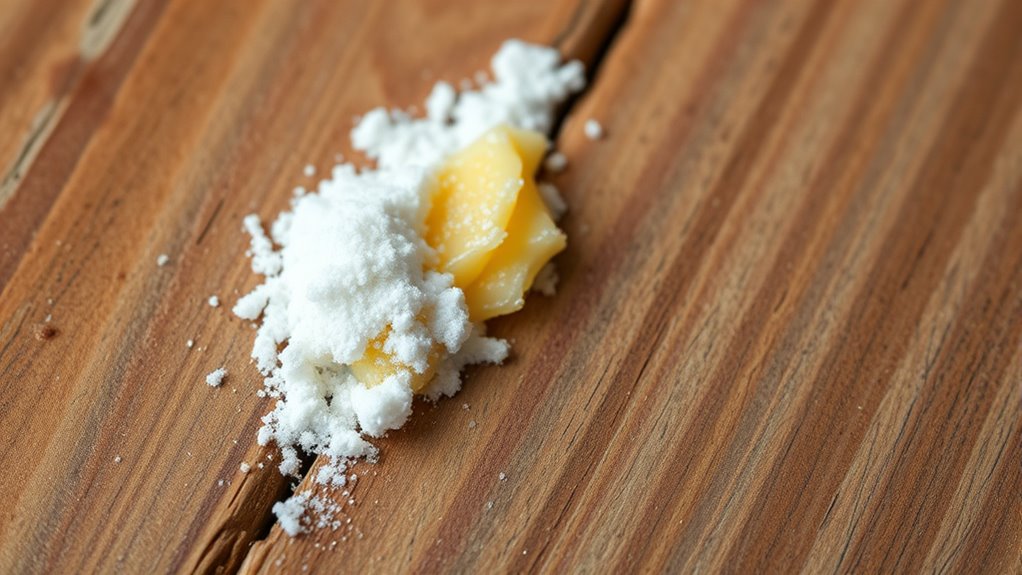
For the best results when using the butter and baking soda mixture on your furniture, paying attention to common pitfalls can make a big difference. Always match the mixture’s application to the wood grain to guarantee a seamless blend. Avoid over-application, which can create uneven texture or dull the finish sheen. Test the mixture on a hidden area first to see how your furniture reacts, especially with different wood types and finishes. Be cautious not to scrub too hard, as this can damage the surface or remove the existing finish. After application, gently buff with a soft cloth to restore the natural finish sheen. Proper technique helps maintain the wood’s appearance and prevents unintended damage, giving you a professional-looking repair. Additionally, understanding personal development principles such as patience and consistent effort can improve your DIY skills over time.
Additional Home Remedies for Minor Wood Damage
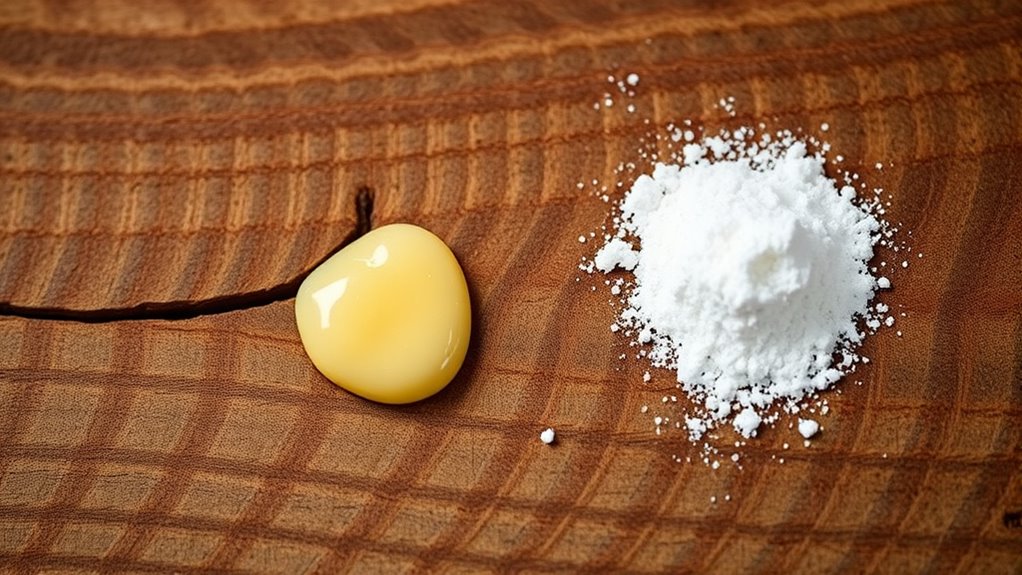
When dealing with minor wood damage, several simple home remedies can help restore your furniture’s appearance without professional help. Natural remedies like olive oil, lemon oil, and toothpaste can work well for small scratches. These options are affordable and easy to apply, offering effective wood repair without harsh chemicals. Here’s a quick comparison:
| Remedy | Best Use | Notes |
|---|---|---|
| Olive oil | Dark scratches | Adds shine, darkens slightly |
| Lemon oil | Light scratches | Brightens, nourishes wood |
| Toothpaste | Fine scratches | Fills shallow marks |
Using these natural remedies, you can often minimize minor damage, keeping your wood surfaces looking fresh and polished. Additionally, understanding wood repair techniques can help you choose the best approach for different types of damage.
Maintaining Your Wooden Surfaces to Prevent Future Scratches

After using natural remedies to repair minor scratches, taking proactive steps to maintain your wooden surfaces can help prevent future damage. Regularly applying a wood stain can protect the surface and keep scratches less noticeable. Using a quality furniture polish creates a protective barrier, reducing friction that causes scratches. Always lift objects instead of dragging them across the surface, and avoid placing sharp or heavy items directly on your wood. Keep your furniture clean and dust-free, as dirt can act like sandpaper. When not in use, cover your wood with soft pads or cloths. These simple habits preserve the finish and prevent new scratches, ensuring your wooden surfaces stay beautiful and durable for years to come. Additionally, incorporating maintenance routines such as periodic inspections and touch-ups can extend the lifespan of your furniture.
Frequently Asked Questions
Is This Method Suitable for All Types of Wood Finishes?
You might wonder if this method works for all wood types and finish compatibility. It’s generally suitable for most common woods like pine or oak, but always consider the wood type and finish before applying. Some finishes, especially lacquer or shellac, may not respond well. Test on a small hidden area first to verify the butter and baking soda mixture won’t damage or discolor your wood finish.
How Long Should I Wait Before Buffing the Repaired Area?
You should wait at least 15 to 30 minutes after applying the filler before buffing the repaired area. This waiting period allows the filler to set and dry properly, ensuring a smooth finish. Rushing the buffing time can cause damage or unevenness. Check that the area feels dry to the touch before you start buffing, and use gentle pressure for best results.
Can Butter and Baking Soda Damage the Wood Over Time?
You might wonder if butter and baking soda can damage your wood over time. While they can temporarily fill scratches, they may affect the wood’s finish and disrupt the natural wood grain if left uncleaned. Over time, moisture from butter could cause swelling or staining, and baking soda might wear down the finish. For long-term protection, it’s best to use products specifically designed for wood repair to guarantee finish compatibility and maintain the wood’s integrity.
Are There Any Safety Concerns When Using This Mixture?
While some believe butter and baking soda are safe for minor uses, there are safety concerns to contemplate. You should be aware of food safety issues, like bacteria growth, and allergy concerns, especially if you or others have nut or dairy allergies. Using this mixture on wood isn’t a food product, so it’s best to avoid ingestion or prolonged skin contact. Always clean the area thoroughly afterward to prevent any potential hazards.
How Does This Method Compare to Commercial Wood Repair Products?
You’ll find that using butter and baking soda is quite cost-effective and easy to use compared to commercial wood repair products. While commercial options often offer specialized formulas and faster results, they can be pricier and sometimes require more precise application. In contrast, this natural mixture is simple, safe, and inexpensive, making it a practical choice for minor scratches. However, for deep or extensive damage, commercial products might provide longer-lasting, more professional results.
Conclusion
Using butter and baking soda is a simple, natural way to hide minor scratches on your wood furniture. Did you know that over 60% of homeowners prefer eco-friendly solutions for home repairs? By following these easy steps, you can restore your furniture’s beauty without harsh chemicals. Keep up with regular maintenance, and your wooden surfaces will stay looking their best for years to come. Give this natural fix a try—you might be surprised by how well it works!

